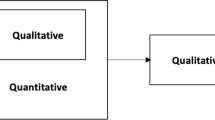Abstract
Empathy maps are currently used to help developers understand their users’ needs and aims. We present the results of an empathy map-based design process, in terms of user satisfaction with user experience. The goal of the project was to develop a new technology for a reminiscence therapy-based multimodal intervention aimed to improve the reality orientation and the behaviour of older people with major neurocognitive disorders.
Access this chapter
Tax calculation will be finalised at checkout
Purchases are for personal use only
Similar content being viewed by others
References
Harper, S.: Living longer within ageing societies. J. Popul. Age. 12(2), 133–136 (2019). https://doi.org/10.1007/s12062-019-09248-4
Belikov, A.V.: Age-related diseases as vicious cycles. Ageing Res. Rev. 49, 11–26 (2018). doi:https://doi.org/10.1016/j.arr.2018.11.002
Dindelegan, C.M., Faur, D., Purza, L., Bumbu, A., Sabau, M.: Distress in neurocognitive disorders due to Alzheimer’s disease and stroke. Exp. Ther. Med. 20, 2501–2509 (2020)
Claudio, A., et al.: Position statement of the Brazilian society of sports medicine and Brazilian society of geriatrics and gerontology: physical activity and health in the elderly. Revista Brasileira de Medicina do Esporte 6(2), (2000)
Eurostat.: Ageing Europe-statistics on population developments. https://ec.europa.eu/eurostat/statistics-explained/index.php?title=Ageing_Europe_-_statistics_on_population_developments#Older_people_.E2.80.94_population_overview
McDermott, O., et al.: Psychosocial interventions for people with dementia: a synthesis of systematic reviews. Aging Ment. Health 23(4), 393–403 (2019)
Kurz, A.: Psychosoziale interventionen bei demenz [Psychosocial interventions in dementia]. Nervenarzt 84(1), 93–103; quiz 104-5 (2013)
Goodall, G., et al.: The use of virtual and immersive technology in creating personalized multisensory spaces for people living with dementia (SENSE-GARDEN): protocol for a multisite before-after trial. JMIR Res. Protoc. 8(9), e14096 (2019)
Tochetto, J., Guimarães, C., Maranho, A.L., Tartari, A.L.: Design with me: i have special needs! the case for cerebral palsy. In: Antona, M., Stephanidis, C. (eds) Universal Access in Human-Computer Interaction. Methods, Techniques, and Best Practices. UAHCI 2016. Lecture Notes in Computer Science, vol 9737, pp. 214–222. Springer, Cham (2016)
Mitchel, E.: Design Defined: What Does “Hierarchy of Needs” Mean To Product Designers? (2019) https://www.bresslergroup.com/blog/design-defined-hierarchy-of-needs-product-design-principles/
Woods, B., O'Philbin, L., Farrell, E.M., Spector, A.E., Orrell, M.: Reminiscence therapy for dementia. Cochrane Database Syst. Rev. (3), CD001120 (2018)
Goodall, G., Taraldsen, K., Serrano, J.A.: The use of technology in creating individualized, meaningful activities for people living with dementia: a systematic review. Dementia 20(4), 1442–1469 (2021)
Ciobanu, I., et al.: Safety aspects in developing new technologies for reminiscence therapy: insights from the SENSE-GARDEN Project. RJGG, 8(2) (2018)
Macleod, F., Storey, L., Rushe, T., McLaughlin, K.: Towards an increased understanding of reminiscence therapy for people with dementia: a narrative analysis. Dementia 20(4), 1375–1407 (2021)
Kawai, H., et al.: Longitudinal study of procedural memory in patients with Alzheimer-type dementia. No To Shinkei 54(4), 307–311 (2002)
Jia, R.X., Liang, J.H., Xu, Y., Wang, Y.Q.: Effects of physical activity and exercise on the cognitive function of patients with Alzheimer disease: a meta-analysis. BMC Geriatr. 19(1), 181 (2019)
Woods, B., Aguirre, E., Spector, A.E., Orrell, M.: Cognitive stimulation to improve cognitive functioning in people with dementia. Cochrane Database Syst. Rev. 15(2), CD005562 (2012)
Acknowledgments
This work was performed in the frame of the EU projects SENSE-GARDEN (AAL/Call2016/054-b/2017) and SENSE-GARDEN Home (AAL-SCP-2020-7-270-SGH-1). We thank to the entire SENSE-GARDEN team and to all the participants in our testing sessions and studies.
Author information
Authors and Affiliations
Corresponding author
Editor information
Editors and Affiliations
Rights and permissions
Copyright information
© 2022 The Author(s), under exclusive license to Springer Nature Switzerland AG
About this paper
Cite this paper
Broekx, R., Serrano, J.A., Ciobanu, I., Iliescu, A., Marin, A., Berteanu, M. (2022). Using Technology to Create Personalised Environments for Dementia Care: Results of an Empathy Map Study. In: Arai, K. (eds) Intelligent Computing. SAI 2022. Lecture Notes in Networks and Systems, vol 508. Springer, Cham. https://doi.org/10.1007/978-3-031-10467-1_14
Download citation
DOI: https://doi.org/10.1007/978-3-031-10467-1_14
Published:
Publisher Name: Springer, Cham
Print ISBN: 978-3-031-10466-4
Online ISBN: 978-3-031-10467-1
eBook Packages: Intelligent Technologies and RoboticsIntelligent Technologies and Robotics (R0)




